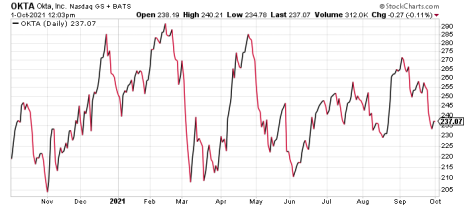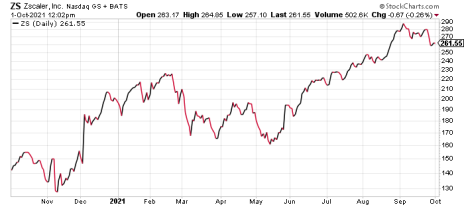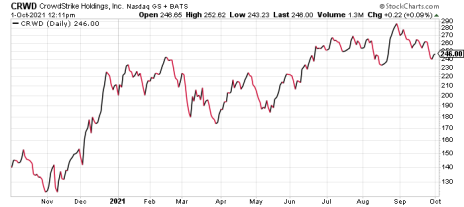Cloud security stocks are doing well as the pandemic abates and cyberattacks ramp up. Here are my three favorite stocks. Which should you buy now?
When news first broke last November that we would likely have an effective vaccine for Covid-19, there was a knee-jerk negative reaction in many growth stocks. The idea at the time was that when the world returns to “normal” many growth stocks that have done well during the pandemic would falter, as their growth rates would slow. That thesis played out for a little while, but growth stocks have roared back. Among the strongest performing have been cloud security stocks.
Big picture, the reasons are twofold: Covid-19 variants and slow vaccine rollouts in areas of the world are prolonging the pandemic, and cyberattacks have surged, as are the prices hackers are asking for.
This has led to strong performance in cloud security stocks, which offer protection against attacks and deployment and management flexibility for clients owing to their cloud-based delivery model.
[text_ad]
A quick look at three cloud security stocks provides interesting insight into the dynamics of the “stronger for longer” argument that I’ve been making to subscribers of both Cabot Small-Cap Confidential and Cabot Early Opportunities.
Without further ado, here we go.
Cloud Security Stock #1: Okta (OKTA)
Okta (OKTA) has a market cap of $37 billion and developed the first cloud-based platform for identity and access management solutions, which is a roughly $25 billion dollar market today. The company is moving upmarket from mid-size to larger companies.
Revenue was up 43% in fiscal 2021, which ended in January, and it is tracking toward being up at least 46% in fiscal 2022. That trajectory was confirmed after the company’s Q1 fiscal 2022 report, which showed that revenue grew by 37% and should grow by nearly 50% in Q2 and Q3. Management also updated its guidance for fiscal 2022 to 47% to 48% growth, which is slightly ahead of consensus estimates.
After the report the stock dipped due to the departure of the CFO (who was just named in December) and long-term growth guidance of $4 billion in revenue in fiscal 2026, which implies just 35% average annual growth. Stepping back, that guidance seems very conservative, especially over the next couple of years. With the stock currently trading 18% off its all-time high and with a little confusion on the part of investors (should be temporary) this may be a good time to start a position in what should be a strong-performing stock over the next five years.
This is what the chart looks like.
Cloud Security Stock #2: Zscaler (ZS)
Let’s move on to Zscaler (ZS), which has a market cap of $36 billion. The company is a provider of network security solutions for many of the biggest companies out there. Its software does things like replacing VPN appliances and providing connections that are used to route traffic between an organization’s headquarters and remote locations.
Naturally, these services are in high demand during the pandemic. But Zscaler is one of the few high-growth companies that’s still enjoying accelerating growth, so clearly its products in a roughly $20 billion market are working. It is grabbing more customers and landing bigger deals as customers are now all in on cloud transformation.
Revenue was up 42% in fiscal 2020 (ended in July). Growth has accelerated through the first three quarters of fiscal 2021 and reached 60% in Q3, which remained relatively consistent through the end of the fiscal year, coming in at 57% in Q4.
Impressively, EPS should grow faster as the business keeps scaling up and more money flows to the bottom line.
Put it all together and you get a stock that is trading just below all-time highs (along with many other growth stocks given the challenges that September presented). Any way you slice it the growth here is impressive.
Cloud Security Stock #3: CrowdStrike (CRWD)
Last up is CrowdStrike (CRWD), which has a market cap of $56 billion. The company provides endpoint security solutions for things like laptops, desktops and IoT devices. CrowdStrike’s platform was born in the cloud so it’s always been there – no messy changes from the on-premise to cloud business model or anything like that here. CrowdStrike is taking market share from legacy players as enterprises are more comfortable turning off their old solutions and moving to the cloud now.
Revenue was up 93% in fiscal 2020 and 82% in fiscal 2021, which ended in January. Current consensus estimates suggest revenue will grow by 56% to $1.36 billion in Fiscal ‘22 and that EPS will grow by 44% to $0.39.
The company reported Q2 fiscal 2022 results at the end of August and they beat expectations – a good thing given the stock traded at almost 30 times 2022 estimated revenue at the time. Revenue was up 70% to $337 million and adjusted EPS was $0.11.
Management said the major growth drivers continue to be the shift to the cloud and growing demand for solutions due to cyberattacks. The percentage of customers with multiple products (more than five) increased by 3%, to 53%.
The stock, like many other growth titles, traded down through September but remains in a long-term uptrend. It remains a very expensive stock, but also one that continues to deliver. I like it as a long-term holding but would suggest averaging in, with smaller purchases at this level.
My Favorite Cloud Security Stock
Stepping back, what we see here is evidence of the stronger for longer thesis playing out among cloud-based security software stocks. The transformation that was happening prior to the pandemic has only gained momentum during it and should sustain afterwards.
If you already own these stocks, I think you should continue to hold on. If you don’t, my preference is to buy smaller amounts of CrowdStrike and/or Zscaler, but recognize that these types of super-growth stocks can pull back 30% at any time. The goal is to build a position over time as they are long-term growers, not flash-in-the-pan-type stories.
As always, position sizing matters. After this recent run a smaller amount invested makes more sense. Average in, try to buy on pullbacks, and let the dollar cost averaging strategy pull you into your desired position size over time.
*This post has been updated from a previously published version.
[author_ad]




